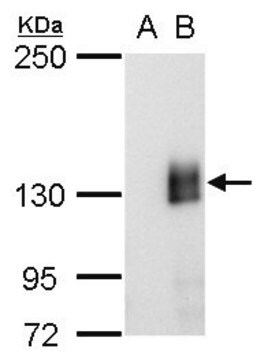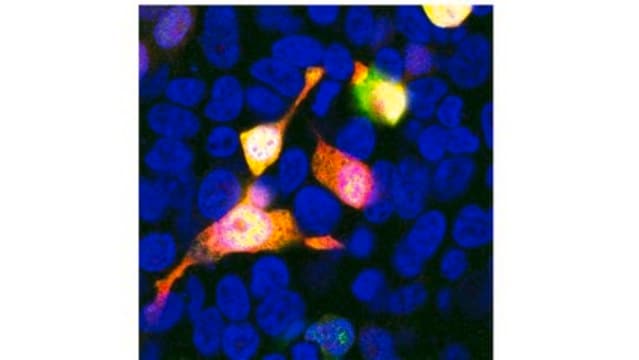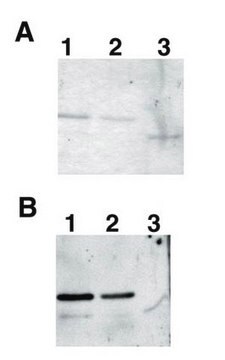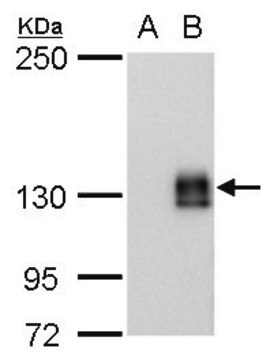AB356482
Anti-mCherry
from rabbit
Sinônimo(s):
Anti-mCherry Antibody
Faça loginpara ver os preços organizacionais e de contrato
About This Item
Código UNSPSC:
12352203
eCl@ss:
32160702
NACRES:
NA.41
Produtos recomendados
fonte biológica
rabbit
Nível de qualidade
forma do anticorpo
affinity isolated antibody
tipo de produto de anticorpo
primary antibodies
clone
polyclonal
reatividade da espécie (prevista por homologia)
all
técnica(s)
immunofluorescence: suitable
western blot: suitable
Isotipo
IgG
nº de adesão UniProt
Condições de expedição
ambient
modificação pós-traducional do alvo
unmodified
Descrição geral
mCherry, red fluorescent protein, is derived from DsRed, a red fluorescent protein from disc corals of Discosoma species. DsRed is similar in size and other properties to GFP, but it produces a red rather than a green fluorescence. mCherry is a monomeric form that has been engineered with multiple cycles of mutation, directed modification and evolutionary selection. It exhibits excitation maximum at 587 nm and an emission maximum at 610 nm with a fluorescent quantum yield of 0.22. mCherry displays high photostability and resistant to photobleaching. It also displays improved brightness and extremely rapid maturation rate. Anti-mCherry, polyclonal is an affinity purified antibody that recognizes mCherry in HEK293 cells transfected with pFin-EF1-mCherry. (Ref.: Schaner, NC et al. (2004). Nat. Biotechnol. 22(12):1567-72; Gross, LA et al. (2000). Proc. Natl. Acad. Sci. USA. 97(22):11990-95).
Especificidade
This polyclonal antibody detects mCherry in HEK293 cells tranfected with pFin-mCherry.
Imunogênio
Epitope: unknown
His-tagged full length recombinant mCherry from Discosoma sp (Mushroom anemone).
Aplicação
Detect mCherry protein using this rabbit polyclonal anti-mCherry Antibody, Cat. No. AB356482. It has been tested in Immunofluorescence and Western Blotting.
Immunofluorescence Analysis: A 1:500 dilution from a representative lot detected mCherry in HEK293 cells transfected with pFin-EF1-mCherry vector. (Courtesy of Dr Gerry Shaw).
Western Blotting Analysis: A 1:1,000 dilution from a representative lot detected mCherry in HEK293 cells transfected with pFin-EF1-mCherry vector. (Courtesy of Dr Gerry Shaw).
Western Blotting Analysis: A 1:1,000 dilution from a representative lot detected mCherry in HEK293 cells transfected with pFin-EF1-mCherry vector. (Courtesy of Dr Gerry Shaw).
Research Category
Secondary & Control Antibodies
Secondary & Control Antibodies
Qualidade
Evaluated by Western Blotting in HEK293 cells transfected with pFin-EF1-mCherry vector.
Western Blotting Analysis: A 1:2,000 dilution of this antibody detected mCherry in 10 µg lysate from HEK293 cells transfected with pFin-EF1-mCherry vector.
Western Blotting Analysis: A 1:2,000 dilution of this antibody detected mCherry in 10 µg lysate from HEK293 cells transfected with pFin-EF1-mCherry vector.
Descrição-alvo
~32 kDa observed, 26.72 kDa calculated. Uncharacterized bands may be observed in some lysate(s).
forma física
Affinity Purified
Format: Purified
Purified rabbit polyclonal antibody in PBS with 0.03% sodium azide and 50% glycerol.
Armazenamento e estabilidade
Stable for 1 year at -20°C from date of receipt.
Handling Recommendations: Upon receipt and prior to removing the cap, centrifuge the vial and gently mix the solution. Aliquot into microcentrifuge tubes and store at -20°C. Avoid repeated freeze/thaw cycles, which may damage IgG and affect product performance.
Handling Recommendations: Upon receipt and prior to removing the cap, centrifuge the vial and gently mix the solution. Aliquot into microcentrifuge tubes and store at -20°C. Avoid repeated freeze/thaw cycles, which may damage IgG and affect product performance.
Outras notas
Concentration: Please refer to lot specific datasheet.
Exoneração de responsabilidade
Unless otherwise stated in our catalog or other company documentation accompanying the product(s), our products are intended for research use only and are not to be used for any other purpose, which includes but is not limited to, unauthorized commercial uses, in vitro diagnostic uses, ex vivo or in vivo therapeutic uses or any type of consumption or application to humans or animals.
Not finding the right product?
Try our Ferramenta de seleção de produtos.
Código de classe de armazenamento
10 - Combustible liquids
Classe de risco de água (WGK)
WGK 2
Certificados de análise (COA)
Busque Certificados de análise (COA) digitando o Número do Lote do produto. Os números de lote e remessa podem ser encontrados no rótulo de um produto após a palavra “Lot” ou “Batch”.
Já possui este produto?
Encontre a documentação dos produtos que você adquiriu recentemente na biblioteca de documentos.
Hao-Shan Chen et al.
Nature communications, 13(1), 3605-3605 (2022-06-24)
The cell-type-specific recording and manipulation is instrumental to disentangle causal neural mechanisms in physiology and behavior and increasingly requires intersectional control; however, current approaches are largely limited by the number of intersectional features, incompatibility of common effectors and insufficient gene
Vijeta Jaiswal et al.
Frontiers in bioengineering and biotechnology, 11, 1142415-1142415 (2023-05-08)
Aedes mosquitoes transmit several pathogens including flaviviruses to humans which result in high morbidity and mortality. Owing to adaptability and climate change, these mosquito vectors are predicted to establish in new geographical areas thus exposing larger populations to the risk
Tong Xiao et al.
Nature chemical biology, 14(7), 655-663 (2018-06-06)
The unusually high demand for metals in the brain, along with insufficient understanding of how their dysregulation contributes to neurological diseases, motivates the study of how inorganic chemistry influences neural circuitry. We now report that the transition metal copper is
Gen Li et al.
EMBO reports, 22(3), e51163-e51163 (2021-01-26)
The phagosome harboring the bacterial pathogen Legionella pneumophila is known to be enriched with phosphatidylinositol 4-phosphate (PtdIns4P), which is important for anchoring a subset of its virulence factors and potentially for signaling events implicated in the biogenesis of the Legionella-containing
Jiaqi Sun et al.
Frontiers in plant science, 13, 817251-817251 (2022-03-15)
ROOT HAIR DEFECTIVE3 (RHD3) is a plant member of atlastin GTPases, which belong to an evolutionally conserved family of proteins that mediate the homotypic fusion of the endoplasmic reticulum (ER). An atlastin in mammalian cells has recently been shown to
Nossa equipe de cientistas tem experiência em todas as áreas de pesquisa, incluindo Life Sciences, ciência de materiais, síntese química, cromatografia, química analítica e muitas outras.
Entre em contato com a assistência técnica








